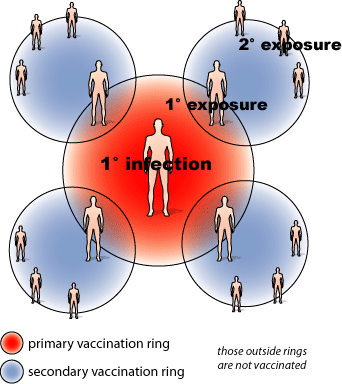The recent Ebola outbreak asks for creative solutions
As a virus-fighter I follow the news about the recent Ebola outbreak in Congo with special interest, since I was involved in training specialized research teams to fight the previous Ebola outbreak in West-Africa in 2014. This was the most widespread Ebola outbreak in history, more than 28,000 people were infected and over 11,000 people died.
Ebola is thought to spread over long distances by fruit bats and can be transmitted to humans when eating contaminated bushmeat. Symptoms start between 2 and 21 days after infections and can include fever, sore throat, muscular pains and headaches and could in the first phase easily be mistaken for other (viral) infections. These symptoms are usually followed by diarrhea, vomiting and decreased function of liver and kidneys and rash. At this point some (but not all) patients start to bleed internally and externally (that is where the term hemorrhagic fever comes from) and has a 25-90% mortality. The virus spreads rapidly via direct contact with body fluids (including blood, vomit, feces, semen and breast milk). There is no cure for Ebola, only treatment of the symptoms. Back in 2014 there was no vaccine available, and stopping the outbreak largely depended on rapid diagnosis and isolation of infected individuals.
Copyright The Wall Street Journal
Most cases of the current outbreak (46, of whom 21 have been confirmed to have Ebola) have been reported in remote villages. Rapid diagnoses is problematic, as samples need to be transported to the national laboratory in Kinshasha for testing, making it difficult to isolate patients on time. Local field laboratories are needed to speed up the diagnostic process. The first cases have now been reported in Mbandaka, a major city (1.2 million people) located next to the Congo River. The Congo River is the regions “high way” to other major cities in the area including the capital Kinshasha (11 million people) and crosses two other countries. The fear is that if the virus is not stopped in time it may spread to other major cities and countries, creating a similar health crisis as in 2014.
A major operation is being put in place to transport over 7000 doses of a novel vaccine (VSVDG-ZEBOV-GP) to the epicentre of the Ebola outbreak. The vaccine will be used in two ways: 1) to vaccinate health care workers, who are most vulnerable to exposure and 2) for ring vaccination around infected individuals, hence close contacts and contacts of contacts will be vaccinated in the hope to prevent further spread of the virus.
Although we seem better prepared as in 2014, there are still major challenges that ask for creative solutions from virus-fighters involved:
- The vaccine must be stored at -80°C at all times, which is a major challenge in a country with a tropical climate and high humidity, especially since power supplies are not reliable.
- The vaccine has not yet been officially licensed which means that informed signed consent is needed from every person to be vaccinated, which is especially challenging considering the logistical, cultural and language barriers. Health care workers will need translators for several local languages.
- Ring vaccination requires to first vaccinate close contacts and contacts of contacts, but people not at immediate risk may also demand vaccines. So, informing the community on what you are doing and why is of outmost importance.
- To get health care workers, vaccines, medical and laboratory supplies to the infection area is another aspect of the challenge. There are no airports that can handle large airplanes and local villages can only be reached by motorbikes or foot, which is particularly challenging during the current rain season.
- Finally, it is crucial that communities understand how to protect themselves, so encaging communities in prevention efforts is very important. For example, traditional cultural behavior around funerals may need to change temporarily, as these are often accompanied by physical contact with the deceased who is still infectious.
Copyright The Science Creative Quarterly
Being a virus-fighter is not only about developing new vaccines, it is also about finding creative solutions in unexpected and challenging situations. It will be therefore of special interest what the solutions of this year’s Ebola-teams will be to tackle these challenges.
Copyright main image: CNN
Artikel: https://edition.cnn.com/2018/05/24/health/ebola-congo-outbreak-patients-escape/index.html



